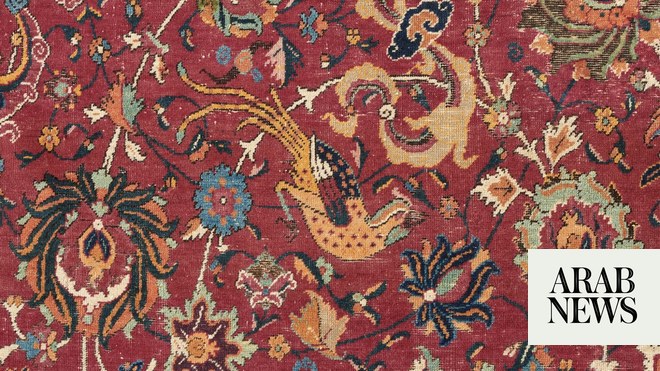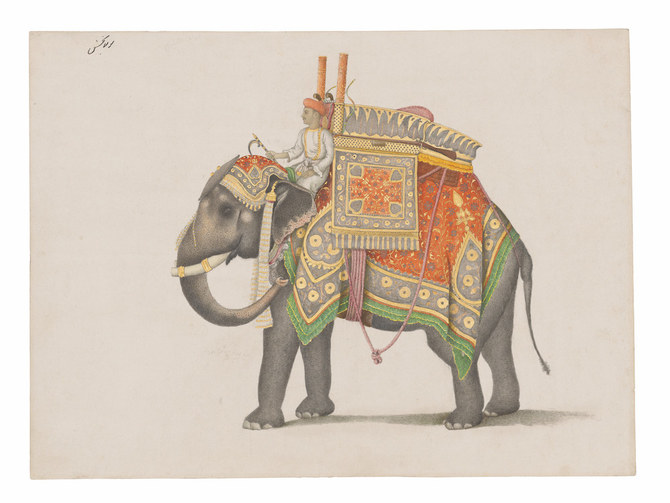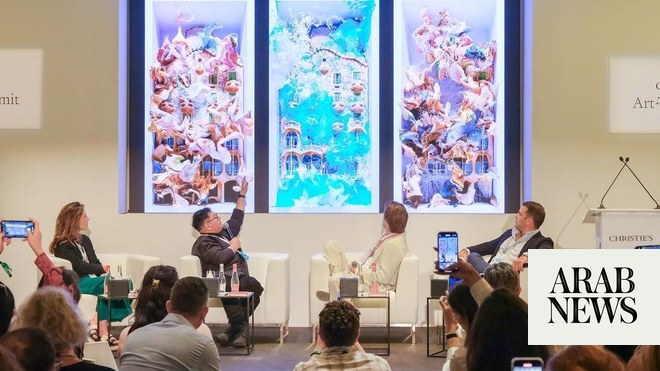
DUBAI: A meticulously crafted carpet from 16th century Persia went on display at Christie’s Dubai this week, marking a prelude of what is to come in Christie’s autumn edition of the Art of the Islamic and Indian Worlds auction in London, taking place on Oct. 26.
For the latest updates, follow us on Instagram @arabnews.lifestyle
The sale will offer a curated selection of ceramics, manuscripts, carpets, textiles, works on paper and metalwork from the Islamic world spanning the 9th century to the 20th century and featuring a diversity of artistic traditions, hailing from a geographical area stretching from Spain through to Central Asia.
The Baron Edmond de Rothschild “Bird and Palmette” Imperial Safavid carpet is one of the stars of the auction. Likely woven between 1565-1575 in Qazvin in central Persia, during the reign of the enlightened Shah Tahmasp, it is a jewel to behold, utterly mesmerizing for its ornate attention to detail and sumptuous coloring. It is being sold for a starting estimate of £2,000,000–3,000,000.
“With so few examples remaining in private hands of this quality it is a rare opportunity to appreciate such a superbly preserved icon of Safavid art, firsthand,” said Louise Broadhurst, International Head of Rugs and Carpets, in a statement. “The sale showcases further extraordinary examples of carpet weaving from an unpublished early 16th century ‘Lotto’ rug to the cherished 17th century central Anatolian rug of the American connoisseur James F. Ballard, and more recent 19th century carpets perfect for today’s interior decorators.”
The carpet, which survives in impeccable condition, was produced during the Golden Age of carpet weaving under the Safavid dynasty (1501-1732). The carpets of this period, like this one, are impressive for their meticulous attention to detail, ornate design, and use of sumptuous materials and colors.
“This is the leading lot of the auction,” emphasized Broadhurst to Arab News. “It was created during the reign of one of the greatest Shahs of the Safavid dynasty who was responsible for reigniting and re-identifying with the arts.”
The synergy of art and design during this period produced Safavid art. The design, creative process and aesthetic detail and breadth of the works and objects produced, is, explains Broadhurst, reflected in the Safavid carpet.
This carpet"s provenance can be traced back to the early 19th century, to Baron Edmond James de Rothschild (1845-1934) and his wife Adélaïde, who were members of the banking industry at the time.
Sarah Pumbly, Head of Department of the Islamic and Indian Worlds, told Arab News: “Not only does the sale include the various owner sales, but it includes this single owner sale of 150 paintings, Indian paintings, which come from the collection of Toby Falk, one of the foremost academics in the field of Indian and Islamic painting until he died in 1997. It was compiled over three decades, before he passed away and it is the first time that the paintings have come to the market in 25 years.”
There are examples of painting from various schools across India, from Mughal to Pahari, Deccani, Company School as well as some of the lesser-known Rajasthani centers. Toby felt it was important to identify schools that people hadn"t yet appreciated or understood.
The collection of Toby Falk comprises more than 500 years of Indian painting, including highlights like “A Lesser Coucal” (1777) commissioned by Sir Elijah and Lady Mary Impey as part of the Impey Album, one of the most well-known and sought after group of natural history Company School paintings. There is also a small number of Persian paintings from the 16th to the 19th century as well as one mesmerizing 16th century Ottoman album page.
Other highlights from the sale include a large Khorassan Bronze Incense Burner in the form of a lion from northeast Iran, dating to the 12th century and going for an estimate of £400,000-600,000. Lions have served as a symbol of power and authority since prehistoric times. In Iran, the lion was an important symbol from as early as the Achaemenid period.
There’s also the sword (tulwar), and scabbard from the personal armory of Tipu Sultan (reigned 1782-99) from Mysore, Deccan, India, dated Mauludi 122[4]/1796-97 AD, and estimated at £1,500,000-2,000,000. This sword and another offered have a richly documented provenance, coming from the collection of Charles, the first Marquess and second Earl Cornwallis to whom they were presented during the 18th century.
The sword has been passed down through the family since the 18th century when came into the possession Charles, 1st Marquess Cornwallis and 2nd Earl Cornwallis KG PC (1738-1805) after the death of Tipu Sultan at the fall of Seringapatam.
The Safavid carpet and other highlights from the sale from India made their way to Dubai — a market, including that of Saudi Arabia, which is growing in importance for the auction house.
“The GCC market, with its many new museums and art initiatives that are opening up, they have probably the primary people that I would suspect and expect to be interested in a carpet of like this as there are very few available,” said Broadhurst.
“There’s been a growth in new institutions in the UAE and Qatar,” she continued. “We expect very much increased growth and awareness of the art market in Saudi Arabia.”












